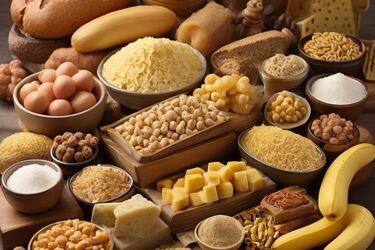Hearty foods that curb hunger

We prepared this article for the girls right after the start of the full-scale war, when stress and new conditions made it impossible to eat. We're not talking about eating properly, systematically, and according to a plan. But it is very important to support the body, so we emphasize that even if you have no appetite or time for yourself, you should definitely (perhaps by forcing yourself) consume at least minimally warm drinks (compotes, rose hips poured with boiling water, teas) and warm liquid food (soups, broths). We hope that there will be as few situations as possible to use our recommendations.
Choose foods high in protein
Protein is good for satiating, supporting muscles and promoting a long-lasting feeling of fullness. It is recommended to add it to your diet:
- Eggs: rich in protein and healthy fats, they can be eaten for breakfast or as a snack.
- Lean meat (chicken, turkey) and fish: rich in protein and low in calories.
- Dairy products: Greek yogurt, cottage cheese, kefir are low-calorie options that provide protein and probiotics.
- The best source of vegetable protein is all legumes: peas, beans, lentils, chickpeas.
Choose whole grain products
They are rich in fiber, which contributes to a long-lasting feeling of satiety:
- Oatmeal: It's a good source of fiber and complex carbohydrates.
- Quinoa, buckwheat, bulgur: These cereals are excellent sources of protein and B vitamins. You don't need to cook buckwheat, oatmeal, or couscous; just pour boiling water over it and let it brew. Oatmeal or buckwheat can also be covered with kefir overnight.
Vegetables are an affordable base
They contain a lot of fiber (essential for the intestines), water, vitamins, and very few calories. They can be added to every meal:
- Leafy vegetables (spinach, arugula, lettuce): rich in vitamins and minerals.
- Broccoli, cauliflower, zucchini: low-calorie vegetables that add volume and nutrition to dishes.
- In fact, any that are available will do: root vegetables (carrots, beets, celery), cabbage, onions, apples. Stew, ferment, bake potatoes in their skins, and make dried fruit compotes. Tomato paste is also good for you - the lycopene in it strengthens the immune system and improves heart function.
Add healthy fats
Healthy fats keep you feeling fuller for longer and support healthy skin and hair:
- Avocado: a source of healthy fats, rich in vitamins and minerals.
- Chia, flax, pumpkin seeds: rich in omega-3s and fiber, can be added to yogurt or smoothies.
- Nuts (almonds, walnuts, cashews): a small portion of nuts is great for satiating and is good for the brain and heart.
Eat more legumes
They are rich in protein, fiber, and B vitamins, which helps maintain energy:
- Lentils, chickpeas, beans: great for soups, salads, or vegetable-based dishes.
Cook cereals
They are well stored and provide energy for a long time if they are whole grains, not ground. Cook cereals and add buckwheat, millet, corn grits, bulgur, pearl barley, wheat, and flattened oatmeal to soups.
Make smoothies based on vegetables and berries
Add vegetables, berries, fruits, or seeds in different proportions and to taste. This snack option is not low in calories, but it is quick to prepare and satisfies hunger.
